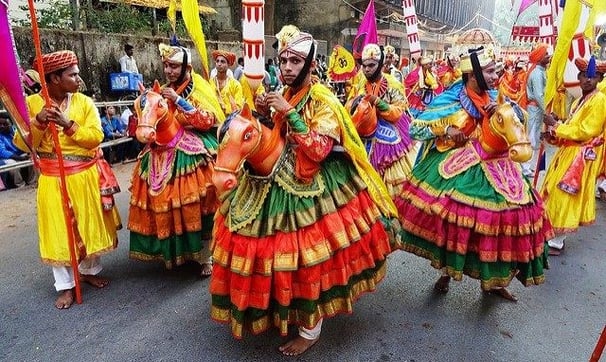Shigmo in Goa
CULTURE


Shigmo: Goa's Spring Festival of Colors and Folklore
As the winter chill fades and the promise of spring fills the air, Goa erupts in a riot of colors, music, and dance – it's Shigmo, the state's vibrant spring festival. More than just a celebration of colors, Shigmo is a deep dive into Goan folklore, mythology, and the rich cultural heritage of the region's agrarian communities.
A Celebration of Spring and Harvest:
Shigmo, also known as Shishirotsava, is Goa's version of Holi, but with its own unique character and traditions. It's primarily celebrated by the rural agricultural communities, marking the end of winter and the beginning of spring. The festival coincides with the Hindu lunar month of Phalgun, typically falling in March.
Unlike the more widespread Holi celebrations focused primarily on colors, Shigmo is a longer, more elaborate festival that incorporates religious rituals, folk dances, and elaborate processions. It’s a celebration of the harvest and a tribute to the deities that protect the villages.
Two Forms, One Spirit:
Shigmo is celebrated in two primary forms:
Dhakto Shigmo (Small Shigmo):
This is the rural, more traditional form, celebrated by the agricultural communities. It involves folk dances like the "Ghode Modni" (horse dance) and "Fugdi," performed by local villagers.
Religious processions carrying deities from local temples are a significant part of Dhakto Shigmo.
Vhadlo Shigmo (Big Shigmo):
This is the more widely known and visually spectacular form, featuring colorful parades in major towns and cities.
Elaborate floats depicting scenes from Hindu mythology and Goan folklore are the highlight of Vhadlo Shigmo.
Street performances, traditional music, and vibrant costumes add to the festive atmosphere.
Key Elements of Shigmo:
Folk Dances and Music:
Traditional Goan folk dances, like "Ghode Modni," "Romta Mel," and "Fugdi," are performed with great enthusiasm, showcasing the rich cultural heritage of the region.
The rhythmic beats of traditional drums and the melodies of folk instruments create a lively and energetic atmosphere.
Mythological Floats:
The parades feature intricately designed floats depicting scenes from Hindu epics like the Ramayana and Mahabharata, as well as local legends and folklore.
These floats are a testament to the artistic skills and creativity of the Goan people.
Colors and Festivities:
While not as prominent as in Holi, colors are still a part of Shigmo, with people playfully smearing colored powder on each other.
The overall atmosphere is one of joy, celebration, and community spirit.
Religious Processions:
The religious aspect of shigmo is very important. Many processions are conducted that carry the Deities of the local temples.
A Cultural Extravaganza:
Shigmo is more than just a festival; it's a cultural extravaganza that showcases the unique traditions and heritage of Goa. It's a time for people to come together, celebrate their cultural roots, and express their joy and gratitude for the bounties of nature.
Experiencing Shigmo:
If you're planning a trip to Goa in March, be sure to experience the vibrant celebrations of Shigmo. The colorful parades, the energetic folk dances, and the festive atmosphere will leave you with lasting memories of Goa's rich cultural heritage.
